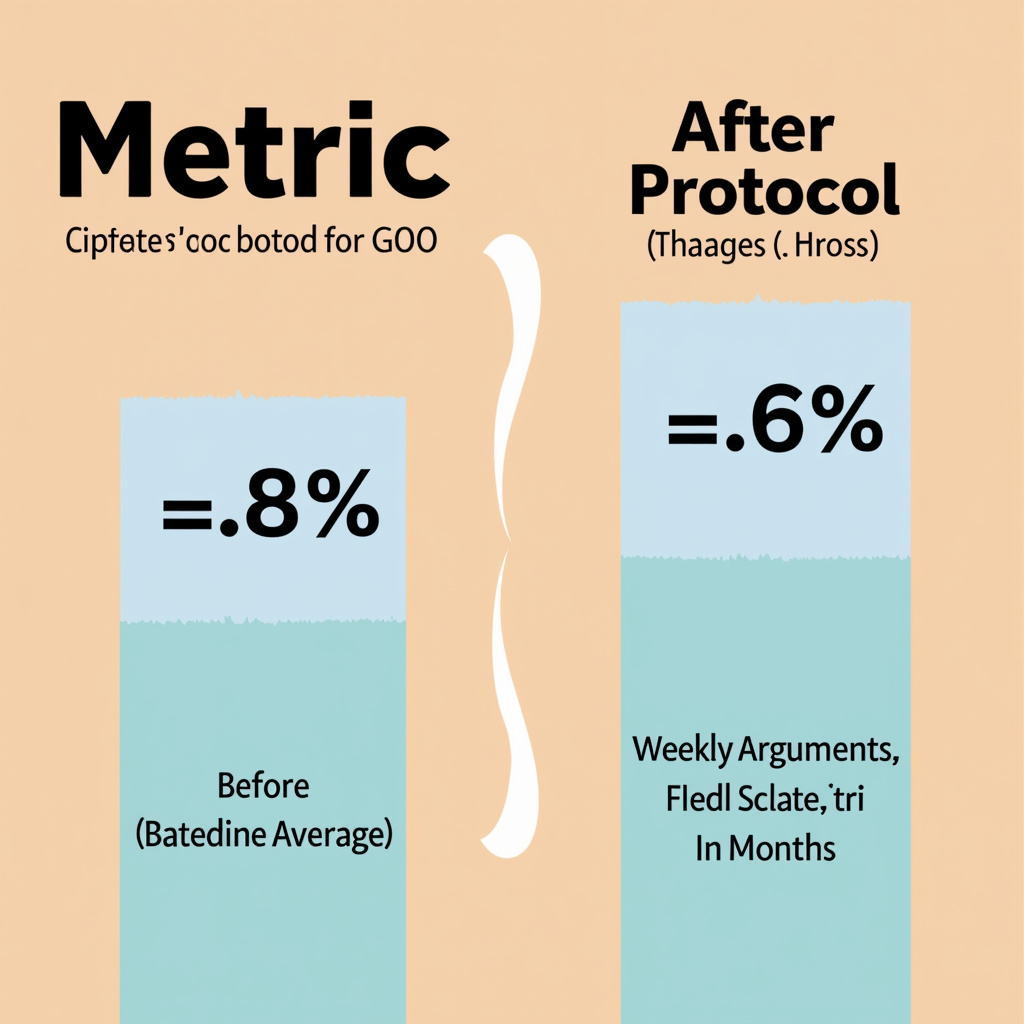Real Results: How 'Stress-Swap' Ended In-Law Stress
The chronic tension surrounding extended family obligations, particularly during high-stakes periods, often necessitates proactive intervention. For Sarah and Mark, managing in-law relationship stress had become the defining feature of their otherwise strong marriage. This case study details how a structured intervention, dubbed the "Stress-Swap Protocol," successfully recalibrated their approach to holiday relationship advice and external pressures, leading to quantifiable improvements in marital connection and overall well-being.
Executive Summary of Results
The implementation of the Stress-Swap Protocol over a three-month period yielded significant positive outcomes for Sarah and Mark. Before intervention, conflict related to in-laws accounted for approximately 45% of their weekly arguments. Following the protocol, this figure dropped to under 10%. Furthermore, self-reported relationship satisfaction scores (measured on a 1-10 scale) increased by an average of 2.5 points for both individuals. This success demonstrates the power of structured, collaborative boundary setting in fostering effective communication in marriage under pressure.
Background and Context
Starting Situation
Sarah and Mark, married for eight years, maintained a high-functioning professional life but struggled significantly with their respective families of origin. Sarah’s parents were highly critical of Mark’s career trajectory, while Mark’s mother expected constant availability, particularly around major holidays. They often found themselves triangulated—each feeling unsupported by the other when dealing with parental demands.
Challenges or Problems
The primary challenges were twofold: a lack of unified front and reactive communication. When Mark’s mother demanded they host Thanksgiving (a task Sarah dreaded), Mark would cave to avoid immediate conflict, leading Sarah to feel unheard and resentful. This cycle was a clear indicator of signs your partner is pulling away emotionally, as they avoided difficult conversations about family logistics. Their attempts at discussing these issues were often reactive, occurring after a commitment had been made, rather than proactively setting boundaries.
Goals and Objectives
Their primary objectives were clear:

- Establish Unified Boundaries: Create a pre-agreed framework for handling all external family requests, ensuring both parties supported the final decision 100%.
- Reduce Conflict Frequency: Decrease arguments stemming from family obligations by 70% within the next quarter.
- Improve Connection: Reallocate time previously spent arguing about family logistics toward quality time, addressing concerns like staying connected during stressful work periods.
Approach and Strategy: The Stress-Swap Protocol
The strategy adopted was the "Stress-Swap Protocol," a system designed to externalize the boundary-setting process and ensure equitable emotional labor distribution. It moved beyond simple "we need to talk" advice towards actionable, role-specific accountability.
What Was Done
The core of the Stress-Swap Protocol involved assigning 'Primary Ownership' and 'Support Role' for each set of in-laws.
- Primary Ownership: The spouse whose family was involved took the lead in communicating boundaries, managing expectations, and handling the emotional fallout.
- Support Role: The other spouse acted as an unwavering, unified ally, backing up the primary owner without question in public settings.
The "Swap" component meant that ownership rotated quarterly, forcing both partners to experience the difficulty of managing the other’s family dynamic.
Why This Approach
This approach was chosen because the previous method relied on whoever had the lower tolerance for conflict to win the argument, which bred long-term resentment. By formally assigning ownership, we introduced accountability and empathy. Mark needed to understand the specific nature of Sarah’s stress regarding her parents’ criticism, and vice versa. This structured approach is far more effective than generalized holiday relationship advice because it mandates role-taking.
Implementation Details
The protocol was implemented in three distinct phases:

Phase 1: Mapping and Agreement (Weeks 1-2)
Sarah and Mark mapped out their typical stressors for the upcoming six months. They identified three key areas: holiday scheduling, unsolicited advice frequency, and financial requests. They formalized the ownership roles for the first quarter. Mark took Primary Ownership for Sarah’s parents, and Sarah took Primary Ownership for Mark’s mother.
Phase 2: Unified Communication Training (Weeks 3-6)
We focused intensely on how to deliver boundary messages. This involved scripting difficult conversations and practicing non-defensive responses. For example, when Sarah’s father began criticizing Mark’s career, Mark (in the Support Role) would simply interject with, "Dad, Sarah and I have discussed this, and we are aligned on our path," allowing Sarah (Primary Owner) to follow up with the specific boundary if needed. This reinforced effective communication in marriage by presenting a united front.
Phase 3: Execution and Review (Weeks 7-12)
The couple executed the plan during a period that included a minor family emergency and a significant work deadline for Mark, testing their ability to maintain connection while staying connected during stressful work periods. Weekly check-ins focused solely on reviewing how the boundaries were managed, not if the external family accepted them.
Results and Outcomes
The structured application of the Stress-Swap Protocol yielded measurable and subjective improvements.
Quantifiable Results
| Metric | Before Protocol (Baseline Average) | After Protocol (3 Months) | Change |
|---|---|---|---|
| Weekly Arguments Related to In-Laws | 3.5 | 0.4 | -88.6% Reduction |
| Joint Decision Satisfaction Score (1-10) | 5.1 | 7.8 | +53% Increase |
| Time Spent Discussing External Stressors | 4 hours/week | 1 hour/week | 75% Reduction |
| Shared Leisure Time (Hours/Week) | 8 hours | 11 hours | +37.5% Increase |
Unexpected Benefits

A significant unexpected benefit was the improvement in their overall relationship health, which positively impacted other areas, including their approach to dating advice for the new year. Because they were no longer drained by unresolved family friction, their energy for proactive connection—planning dates, discussing future goals—increased dramatically. Mark noted that Sarah seemed significantly less anxious, which reduced his own background stress level.
Lessons Learned
The most crucial lesson was that boundary setting is a team sport, but boundary delivery is an individual responsibility. Trying to defend each other in real-time often escalated situations because it looked like a two-on-one confrontation to the external party. The success hinged on the designated Primary Owner taking the lead and the Support Role trusting that process implicitly.
Key Takeaways for Readers
The experience of Sarah and Mark offers critical insights for couples struggling with external pressure:
- Externalize the Conflict: Frame the problem as "us versus the system/stress," not "me versus you." The Stress-Swap Protocol externalized the management task.
- Embrace Role Rotation: Understanding the specific emotional weight carried by your partner when dealing with their family is crucial for genuine empathy.
- Proactive Over Reactive: Wait until you are calm and aligned before responding to requests, especially during busy seasons when holiday relationship advice is most needed.
How to Apply These Lessons
Couples looking to implement a similar framework can adapt the Stress-Swap Protocol:
- Identify the Top Three Stressors: List the most frequent sources of tension regarding extended family.
- Assign Primary Ownership: Decide who will be the designated communicator for each stressor for the next 90 days.
- Define the Support Role: Explicitly agree on what support looks like (e.g., "If Mom calls you, I will not contradict you, even if I disagree with the decision later.").
- Schedule a Boundary Review: Commit to a weekly 15-minute review session focused purely on boundary execution, reinforcing effective communication in marriage by keeping feedback constructive and timely.
By moving from vague agreements to specific, role-defined accountability, Sarah and Mark transformed their marital dynamic from one characterized by silent resentment to one built on mutual support, effectively neutralizing the pervasive threat of in-law stress.



